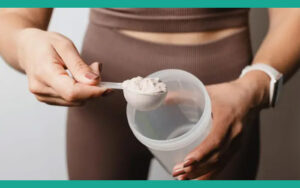Creatine, a supplement traditionally associated with bodybuilding, has gained a prominent place in women’s health recommendations. More and more doctors and trainers suggest it as an effective strategy for middle-aged and menopausal women, since it helps preserve muscle strength, protect bone mass, and support cognitive health.
What is creatine and how does it work in the body?
Creatine is a compound that the body naturally produces from amino acids (arginine, glycine, and methionine) and stores mainly in the muscles and brain. Its primary role is to facilitate the production of adenosine triphosphate (ATP), the body’s main energy source, especially during high-intensity, short-duration activities such as weightlifting or sprinting.

In addition to internal synthesis, creatine is obtained through diet, mainly from red meat and fish. However, according to research published in Nutrients (2021), women have between 70% and 80% lower creatine stores than men, a level that decreases even further with age and the onset of menopause.
Benefits of creatine during menopause
Menopause is accompanied by a sharp decline in estrogen and other hormones, which leads to a loss of muscle and bone mass. This increases the risk of sarcopenia, osteoporosis, falls, and fractures.
- Muscle and bone protection: Clinical studies (such as the one published in Journal of Women’s Health, 2021) indicate that creatine supplementation helps preserve lean mass and strength, especially when combined with resistance training.
- Reduced risk of osteoporosis: Creatine may be a key ally, as sarcopenia doubles the likelihood of fractures.
- Brain and cognitive health: About 20% of the body’s creatine is found in the brain. Supplementation may improve mood, memory, and mental energy—factors especially relevant during menopause.
- Relief of common symptoms: Emerging evidence suggests it may reduce fatigue, brain fog, and mild cognitive decline associated with this stage.

Dr. Lafina Diamandis, quoted by The Independent, highlights that “creatine helps replenish intramuscular stores and improves energy utilization by the muscles, resulting in greater strength and protection against age-related muscle loss.”
Creatine and strength training: the perfect combination
Strength training is considered the most effective tool to prevent osteoporosis and muscle loss in middle-aged women. Creatine supplementation enhances these results.
A 2023 study published in Frontiers in Nutrition showed that combining weightlifting with creatine significantly increases muscle strength compared to training without supplementation, especially in programs lasting more than six months.

In addition, regular strength training improves insulin sensitivity, boosts metabolic health, and helps counteract the decline of estrogen and growth hormone.
Recommended dosage and ways to take it
Creatine monohydrate is the most studied and recommended form. Experts suggest a standard daily dose of 3 to 5 grams, which is safe and effective for women of all ages.
- No loading phase is needed: Consistent daily intake is enough to maintain stable muscle stores.
- Timing: It can be taken at any time of day, though post-workout alongside a meal may enhance absorption.
- Forms: Powder, capsules, or tablets—all equally effective.

Celebrity personal trainer Luke Worthington explained to The Independent: “Creatine is the most studied supplement in history, with thousands of studies supporting its safety and efficacy.”
Conclusion
Scientific evidence is clear: creatine is not just a supplement for young athletes, but a powerful health tool for middle-aged and menopausal women. When combined with strength training and a balanced diet, it helps maintain physical vitality, protect bone density, preserve muscle mass, and support brain health.

